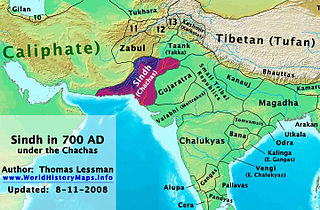Daradas were an ancient people who lived north and north-west to the Kashmir Valley. This kingdom is identified to be the Gilgit region, in the Gilgit-Baltistan region along the river Sindhu or Indus. They are often spoken along with the Kambojas. The Pandava hero Arjuna had visited this country of Daradas during his northern military campaign to collect tribute for Yudhishthira's Rajasuya sacrifice.
The Chinas are a people mentioned in ancient Indian literature, such as the Mahabharata, Manusmriti, and the Puranic literature.
The historical Avanti kingdom of ancient India is described in the Mahabharata epic. Avanti was divided into north and south by river Vetravati. Initially, Mahissati was the capital of southern Avanti, and Ujjaini was of northern Avanti, but at the times of Mahavira and Buddha, Ujjaini was the capital of integrated Avanti. The country of Avanti roughly corresponded to modern Malwa, Nimar and adjoining parts of the Madhya Pradesh.
Madra kingdom was a kingdom grouped among the western kingdoms in the ancient Indian epic Mahabharata. Its capital was Sagala in the Madra region. The Kuru king Pandu's (Pāṇḍu) second wife was from Madra kingdom and was called Madri. The Pandava twins, Nakula and Sahadeva, were her sons. Madri's brother Shalya was the king of Madra. Though affectionate to the Pandavas, he was tricked to give support to Duryodhana and fought against the Pandavas during the Kurukshetra War. He was killed by Yudhishthira, the eldest Pandava. Other than the Madra kingdom with Sagala as its capital, it is believed that there was a Western Madra and a Northern Madra.

Sindhu kingdom or simply Sindhu was an ancient kingdom on the Indian subcontinent. It stretched the banks of river Sindhu (Indus). It was mentioned in the epic Mahabharata and in the Harivamsa Purana, often alongside the Sauvira kingdom. It is believed that Sindhu kingdom was founded by Vrishadarbha, one of sons of Sivi. According to the Glimpses of Ancient Sindh, authored by Mirchandani, its capital was known as Vrsadarbhpura, and Tulsianis, later known as Sindhu, was located at or near the location of the present town of Mithankot the inhabitants of the kingdoms were called Sindhus or Saindhavas. "Sindhu" literally means "river" and "sea". According to the epic Mahabharata, Jayadratha was the king of Sindhus, Sauviras and Sivis. Probably Sauvira and Sivi were two kingdoms close to the Sindhu kingdom and Jayadratha conquered them, holding them for some period of time. Sindhu and Sauvira seem to have been two warring states fighting each other.
Sauvīra was an ancient kingdom of the lower Indus Valley mentioned in the Late Vedic and early Buddhist literature and the Hindu epic Mahabharata. It is often mentioned alongside the Sindhu kingdom. Its capital city was Roruka, identified with present-day Aror/Rohri in Sindh, mentioned in the Buddhist literature as a major trading center. According to the Mahabharata, Jayadratha was the king of the Sindhus, Sauviras and Sivis, having conquered Sauvira and Sivi, two kingdoms close to the Sindhu kingdom. Jayadratha was an ally of Duryodhana and the husband of Duryodhana's sister Dussala. The kingdom of Sauvira is also stated to be close to the Dwaraka and Anarta kingdoms. According to Bhagwat Puran Sauviras were once connected with Abhira.
The Pahlava kingdom is identified to be a kingdom of an Iranian tribe. The kingdom was well known, even during the campaign of Alexander. It was also mentioned in the epic Mahabharata.

The kingdom of Tushara, according to ancient Indian literature, such as the epic Mahabharata, was a land located beyond north-west India. In the Mahabharata, its inhabitants, known as the Tusharas, are depicted as mlechchas ("barbarians") and fierce warriors.
Sakas are described in Sanskrit sources as a Mleccha tribe grouped along with the Yavanas, Tusharas and Barbaras. There were a group of Sakas called Apa Sakas meaning water dwelling Sakas, probably living around some lake in central Asian steppes. Sakas took part in Kurukshetra War.
Khasas were a north western tribe mentioned in the epic Mahabharata.
Kasmira or Kashmira was a kingdom identified as the Kashmir Valley along the Jhelum River of modern Jammu and Kashmir. During the epic ages this was one among the territories of the Naga race. The Kasmiras were allies of the Kuru king Duryodhana.
Hunas were a tribe close to Himalayas that, because of limited interaction with Indian kingdoms, were mentioned in the epic Mahabharata. They belonged to the Xinjiang province of China, east of Jammu-Kashmir. However, they were nomadic people who changed their settlements from time to time.

Hara-Huna was an ancient kingdom and inhabited by the Hara Hunas tribe close to the Himalayas who had limited interaction with the Indian kingdoms, thus they were identified in the epic Mahabharata.
The Keralas or Udra Keralas were a royal dynasty mentioned in Sanskrit epics of ancient India. In the Mahabharata, the Keralian empire took part in the Kurukshetra War by feeding both armies. According to the Puranas, the navigators and survivors of the Yadavas of Dwaraka also settled in Kerala later. Some remnants of the Naga culture are also found here.
Kanchi was a southern kingdom mentioned in the epic Mahabharata. This kingdom took part in the Kurukshetra War.

Kirata kingdom in Sanskrit literature and Hindu mythology refers to any kingdom of the Kiratis, who were dwellers mostly in the Himalayas. They took part in the Kurukshetra War along with Parvatas (mountaineers) and other Himalayan tribes.

The Pahlavas are a people mentioned in ancient Indian texts. According to Patrick Carnegy, a Raj-era ethnographer, the 4th-century BCE Vartika of Katyayana mentions the Sakah-Parthavah, demonstrating an awareness of these Saka-Parthians, probably by way of commerce. Knowledge of the Pahlavas is distilled from the literary references in texts like the Manu Smriti, various Puranas, the Ramayana, the Mahabharata, and the Bṛhat Saṃhitā.

The Bahlikas were the inhabitants of a location called Bahlika, mentioned in the Atharvaveda, Mahabharata, Ramayana, Puranas, Vartikka of Katyayana, Brhatsamhita, Amarkosha, and other ancient inscriptions. Other variations of Bahlika include Bahli, Balhika, Vahlika, Valhika, Bahlava, Bahlam/Bahlim, Bahlayana, and Bahluva.




